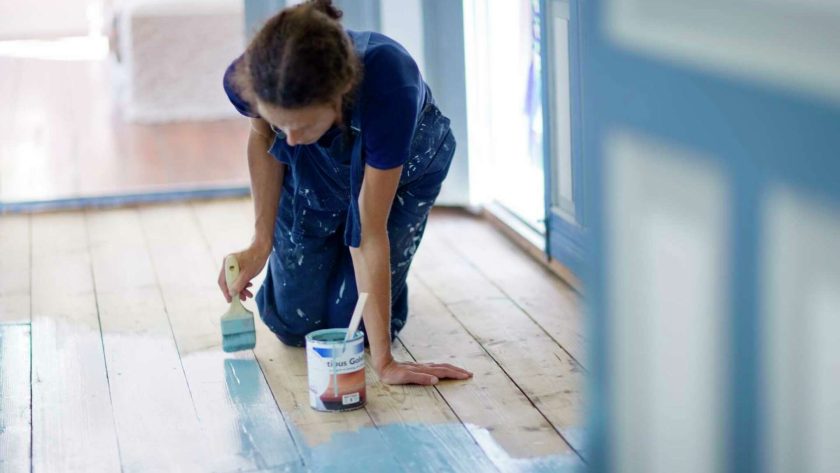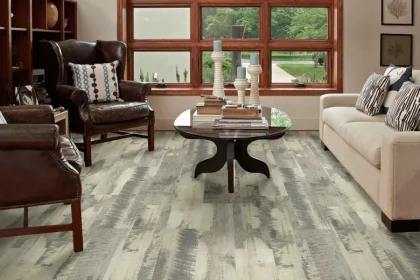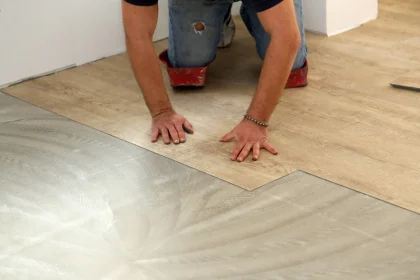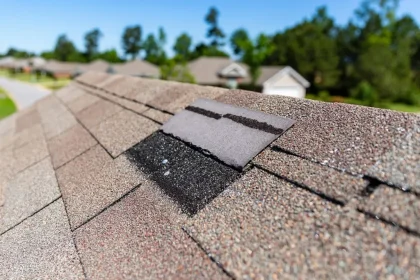Vinyl flooring is a popular choice in many homes because it’s affordable, easy to clean, and available in lots of styles. But what happens when your vinyl floor starts looking tired or outdated? One question that often comes up is, “Can you paint vinyl flooring?” The short answer is yes—you can. However, there are pros and cons to consider before picking up a paintbrush.
In this guide, we’ll break down everything you need to know about painting vinyl floors DIY style, the materials you need, how to do it right, and whether it’s worth your time and effort.
Can You Really Paint Vinyl Flooring?
The good news is that you can paint vinyl flooring if you’re looking for a budget-friendly way to refresh your space. Whether it’s vinyl plank flooring or linoleum floors, painting can be a great option to give your floors a fresh, modern look without the high cost of replacement.
But like any home improvement project, success depends on proper surface preparation, using the best paint for vinyl floors, and following the right steps. Poor preparation can lead to peeling, bubbling, or scuffing over time.
Why People Choose to Paint Vinyl Floors
Sometimes vinyl floors just don’t match your current decor, or maybe they’ve become scratched and faded. Painting them can help you:
- Update the look of your home without replacing flooring
- Cover stains or damage
- Try out a new style or color
- Save money on costly floor replacements
According to Family Handyman, painting floors is considered a budget-friendly flooring transformation that works well in low-traffic areas or as a temporary solution while saving for new floors.
Pros of Painting Vinyl Flooring
1. Cost-Effective Makeover
Replacing vinyl flooring can cost between $3 to $7 per square foot, depending on the type. Painting, on the other hand, can cost as little as $1 per square foot when you factor in the primer, paint, and sealer.
2. Wide Range of Colors and Finishes
Choosing the best paint for vinyl floors, like porch and floor paint or epoxy-based products, gives you plenty of color options. You can go for soft neutrals, bold patterns, or even create a checkerboard effect.
3. Quick DIY Project
Many homeowners prefer painting vinyl floors DIY because it can be done over a weekend. You don’t need to hire professionals, making it an ideal DIY floor makeover.
4. Minimal Tools Required
Basic supplies like sandpaper, floor primer, rollers, and topcoat are usually all you need.
Cons of Painting Vinyl Flooring
1. Durability Issues
Painted vinyl flooring may not last as long as new vinyl or other flooring types. High foot traffic, pets, or moving heavy furniture can lead to scratches and wear, even with proper adhesion and sealer.
2. Prep Work Is Crucial
Skipping proper surface preparation is one of the biggest mistakes. The floor must be cleaned thoroughly and sanded to allow the primer and paint to stick. Without this step, the paint can peel off easily.
3. Limited Moisture Resistance
If your vinyl flooring is in a bathroom or kitchen, moisture can cause the paint to bubble or chip. Always use scuff-resistant paint and sealer to increase longevity.
4. Not a Permanent Fix
If you’re looking for a long-term solution, painting may not be the best option. Painted floors might need touch-ups over time, especially in busy areas.
What You’ll Need: Materials and Tools
To ensure the painting vinyl floors DIY process is successful, gather these supplies:
- Mild degreaser or floor cleaner
- Sandpaper (120-220 grit)
- Vacuum and tack cloth
- Adhesion primer or bonding primer (specifically for glossy surfaces)
- Porch and floor paint or epoxy-based paint
- Polyurethane topcoat or sealer for durability
- Paint rollers and brushes
- Painter’s tape
Step-by-Step Guide: How to Paint Vinyl Flooring
Step 1: Clean the Floor Thoroughly
Start by cleaning the floor with a degreaser to remove any oils, dirt, or residues. Make sure the floor is completely dry before moving on.
Step 2: Sand the Surface for Adhesion
Lightly sand the vinyl flooring with 120-220 grit sandpaper. This step is essential for improving adhesion between the floor and primer. Vacuum the dust and wipe the surface with a tack cloth.
Step 3: Apply a Quality Floor Primer
Use an adhesion primer suitable for slick surfaces like vinyl. Apply one thin coat and allow it to dry completely.
Step 4: Paint with the Right Type of Paint
Use porch and floor paint, which is designed to withstand foot traffic. Apply two thin coats using a roller, letting each coat dry fully before applying the next.
Step 5: Seal for Durability
Once the paint is dry, apply a polyurethane topcoat or sealer to protect against scuffs, scratches, and moisture. This step helps maintain the look of your painted vinyl flooring for longer.
How Durable Is Painted Vinyl Flooring?
The durability of painted vinyl floors depends on:
- The quality of the primer and paint used
- Proper surface preparation
- Whether you apply a scuff-resistant topcoat
- The amount of foot traffic in the area
If done correctly, painted vinyl floors can last anywhere from 1 to 3 years in low-traffic zones like guest bedrooms or laundry rooms. For busy areas, you may need to refresh the paint every year or so.
How Much Does Painting Vinyl Floors Cost?
The cost to paint vinyl floors is quite affordable compared to replacement. Here’s a quick breakdown for a 100-square-foot space:
- Primer: $20–$40
- Paint: $30–$60
- Sealer: $25–$50
- Supplies (rollers, brushes, tape): $20–$40
Total Estimated Cost: Around $100–$190 (prices according to US rates).
This makes it a smart budget-friendly flooring makeover option if you’re not ready to replace the entire floor.
Painting Vinyl Flooring: Before and After
The before and after results of painting vinyl flooring can be pretty impressive if the process is done correctly. A dull, yellowed kitchen floor can become a sleek, modern space with just a few coats of paint. Many homeowners share their success stories on platforms like Pinterest, showing how vinyl floor painting tips helped them achieve a whole new look on a tight budget.
Common Mistakes to Avoid
- Skipping the sanding step—always sand for proper adhesion.
- Using wall paint instead of floor paint—it won’t hold up to foot traffic.
- Forgetting the topcoat—no sealer means the paint will chip faster.
- Painting over damaged vinyl—paint won’t hide deep cracks or loose tiles.
Conclusion: Is Painting Vinyl Flooring Worth It?
So, can you paint vinyl flooring? Absolutely—but only if you’re ready to commit to the prep work and use the right products. Painting vinyl floors is a great short-term solution to refresh your space, especially if you’re on a budget and looking for a quick DIY floor makeover.
While it may not replace the long-term durability of new vinyl or tile, with proper care, painted vinyl floors can look beautiful and last for a couple of years. Whether you’re tackling painting vinyl plank flooring or updating older linoleum floors, following these steps will help you get the best possible result.
If you’re considering this project, weigh the pros and cons carefully and decide if this approach suits your needs. And remember, the key to success lies in the details—so take your time with surface preparation, choose the best paint for vinyl floors, and don’t skip the sealer.
With a little effort, your floors can feel brand-new again—without the big price tag.





